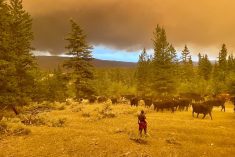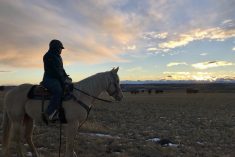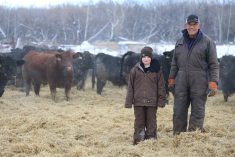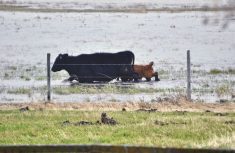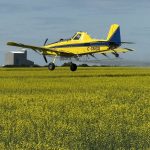Bears love everything about agriculture — the livestock, deadstock, standing crops, binned grain, silage, honey, orchards, gardens, and anything else agriculture provides.
Two decades ago it was a novelty to see a grizzly wander across an Alberta pasture. Not any more, says Jeff Bectell, who ranches south of Cardston, Alta., near the U.S. border, and chairs the Waterton Biosphere Reserve Association (WBRA) as well as its carnivore working group.
The area east of Waterton Lakes National Park and north to the Crowsnest Pass is unique in that it transitions from prairie to mountains in only 10 miles or so, making it a short trek for a hungry grizzly to find plenty to eat on agricultural land.
Some ranchers in the area see grizzlies upwards of 30 times a year now, and trail cameras regularly capture more than one bear frequenting farmyards. Ranchers are becoming convinced bears are being forced to spread into new territory by the pressure of a growing grizzly population in the mountains overlooking their ranches.
- More from the Canadian Cattlemen: Getting a grip on grizzly populations

Ranchers fear for their families and their livestock, saying the bears are becoming bolder with each passing year and the options for dealing with them are limited by a hunting ban that has been in place since 2006.
The southwest corner represents only three per cent of Alberta’s land base, yet 37 per cent of cattle predation claims paid by the provincial predator compensation program from 2000 through 2010 were made to southwest livestock producers. And that’s only the kills deemed eligible by investigating fish and wildlife officers.
The current predator compensation program is another sore point with ranchers. Probable kills are only paid out at 50 per cent of market value and to be considered “probable” the claim has to be backed up with a second kill by the same species of predator within 10 kilometres and 90 days of the first probable kill. Not surprisingly the WBRA is lobbying the province to remove the backup qualifier and pay 100 per cent of market value on probable kills.
Read Also

Body condition, nutrition and vaccination for brood cows
One of the remarkable events of the past century related to ranching has been the genetic evolution of brood cows….
All of these issues were brewing beneath the surface when the grizzly bear issue came to a boil at fish and wildlife public meetings in 2007 and 2008.
A 2004-08 grizzly survey had estimated the provincial population at 691 bears, a number producers felt underestimated the real population. It was, however, low enough that the province decided to list the grizzly as a threatened provincial species that can’t be hunted.
A 2011 survey to determine community attitudes toward large carnivores conducted by Miistakis Institute for the WBRA pegged grizzly bears as the greatest threat to human and livestock safety.
Sixty-six per cent said the current rate of livestock predation was unacceptable but 71 per cent said they can live with large carnivores provided they are being properly managed.
What the community did
“The reality is we’ve got bears,” says Bectell. “Society wants to have bears. Producers don’t want to shoot them all — the intent has never been to get rid of all the bears — so we have a problem. Let’s get together to find solutions.”
In that vein the WBRA started a “carnivores and communities” program in 2009 and formed its carnivore working group in 2011. Here are a few of the projects they’ve gotten up and running since then:
1. Deadstock removal
This became a priority after Montana’s Blackfoot Challenge landowner group showed that carnivore problems can be reduced by removing deadstock. And Alberta had the data to show that deadstock was involved in two-thirds of reported human/bear incidents.
Black bears favour garbage, vegetation, bird feed and grain, with livestock being the main draw in only 10 per cent of the black bear/human incidents reported. Wolves came for living livestock 97 per cent of the time; deadstock was the target in only three per cent of wolf reports
The Drywood-Yarrow Conservation Partnership in Twin Butte was the first landowner group to organize a deadstock removal trial in 2009.
The province paid for two predator-proof deadstock bins that were placed on private land and maintained by the ranchers. The Canadian Food Inspection Agency consulted on specified-risk-material concerns and issued permits allowing producers to deliver carcasses to the bins and on-farm pickup for larger carcasses. A rendering company empties the bins.
Based on that experience the WBRA’s carnivore working group helped ranchers in four municipal districts (MD) set-up deadstock removal zones where predation was a problem. By 2013, 12 bins were located in the MDs of Pincher Creek and Cardston. The nearby Ranchland and Willow Creek MDs have a rendering company pick up deadstock from the ranch.

The 14-gauge steel bins come with hinged lids and drop ends for unloading. “We’ve had bears come to the bins, rip off signs and dig around, but they can’t get in and quit coming because there is no reward, similar to what happened in parks when bear-proof garbage cans were introduced,” Bectell says.
The $28,000 deadstock removal costs from 2009 to 2012 were spread over Alberta Environment and Sustainable Resource Development (AESRD), Environment Canada, WBRA, Shell Canada and the MD of Ranchland. The province paid $21,000 for nine bins and the MD of Pincher Creek $10,000 for three bins.
Cardston County became the first municipality in Canada to operate a deadstock composting facility when it opened in January 2013. Operations were temporarily suspended on May 1 this year and deadstock pickup reverted to a rendering company until the county, AESRD, CFIA and WBRA can sort out the financial and regulatory issues. During the 16 months it was in operation, the facility disposed of some 600 carcasses.
As of January 2013, the deadstock removal program, including composting operations, has been funded by the WBRA’s carnivore working group with grants from the province and Shell Canada.
The cost of running the deadstock pickup and composting program in 2013 was $25,000. Looking forward, the WBRA estimates it will cost $50,000 per year across the four municipalities, basically covering the area from Nanton south to the U.S. border.
2. Grain bin retrofits
“Now that we’ve cleaned up a lot of deadstock from the countryside we are finding out that stored grain and feed is a major attractant for grizzlies,” Bectell says. There is no provincial compensation program for carnivore damage to infrastructure and crops; however, the WBRA’s funding from the province provides support for bins damaged by carnivores.
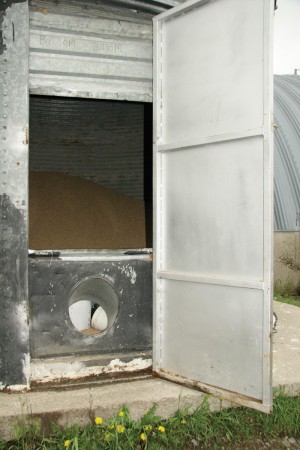
Bears get into bins through the doors or by digging under and through wooden floors. Some have even learned that pounding on the seams of metal bins pops them open enough to let grain trickle out.
Successful bin upgrades were cost-shared with producers and involved replacing wooden bins with metal ones, installing heavy steel doors (custom-made by Haul-All Equipment in Lethbridge), and replacing wooden floors with metal, concrete pads or hopper bottoms.
Three producers are using revamped sea shipping containers. These ranged in cost from $3,300 for a 20-foot container with few modifications, to $6,000 for a 40-foot container remodelled to store two types of feed with two spouts in the roof, a pony wall divider and a bear-proof man door at the end opposite the original container door.
“If a producer is having problems, we work with them, show them the ideas we have and if the producer has other ideas, we can work with that, too,” Bectell says.
3. Electric fencing
Portable and permanent electric fencing, also cost-shared, has kept bears out of bin yards of all sizes, silage pits and calving areas.
Producers who fence off bins suggest making the enclosure large enough to allow for snow drifts and snow removal as well as the occasional graze instead of mowing in summer. Trimming or spraying herbicide under the fence line is necessary to maintain full shock strength. Many producers who pail feed grain or pellets daily found electric wires cumbersome to work around, so some thought should go into how this chore could be managed. Any bear-tempting grain spills around the bins need to be cleaned up quickly.
One design uses stranded cables which are more conductive and easier to handle than high-tensile wire. Six strands are secured to wooden or heavy-duty fibreglass posts starting two inches above the ground, with six inches to the second wire, eight inches to the third and fourth wires, and 10 inches to the top two wires.
The main drawback to permanent fencing is that it’s not easily moved to create fresh calving and feeding grounds.
Many producers in this area no longer creep feed on pasture to avoid the bears, and save some money. One fellow was going through 36 pounds per head per day.
Several people have installed trail cameras or gained temporary use of fish and wildlife trail cameras, to monitor carnivore activity as a first step toward deciding on a course of action.
4. People Protection
This summer the Canadian Agricultural Safety Association and Farm Credit Canada provided funding for two successful bear spray workshops at Twin Butte and Boundary Creek. Families who came learned how to tell when a bear is acting predatory, defending its young, or just plain curious, plus how to position themselves and factor in distance and wind conditions when using the spray.
5. Intercept feeding
The province suspended its intercept feeding program last spring to assess whether it was worth the cost in terms of its impact on the bears. Highway crews in the area collect and freeze road kill over the winter so it can be flown to the high country by helicopter in spring as the bears emerge from hibernation and are as hungry as, well, a bear. The idea is to keep the bears fed in the moun- tains so they won’t wander down into the ranchland at calving time. The province has been doing it for some years but its effectiveness appears to be declining with the increase in grizzly population.
Bectell says the results were unclear as there was an increase in bear activity in some areas and a decrease in others.
The province redirected $30,000 to other mitigation projects for the first year of the suspension and is expected to do the same for year two when a full review of intercept feeding will be conducted.
For more on WBRA’s projects and proposals visit watertonbiosphere.com.






